Sunday afternoon I was struck with the intense desire to eat mass quantities of pizza. Now I don't get into snotty vegan trash talking, so I wont talk about the locations themselves, but I will say that the vegan pizza options in Philly are good only because they are vegan. They do not satisfy my cravings for serious pizza. It probably has something to do with the fact that I think that the pizza in 90% of this country is terrible and not worth paying for. This post is not so much about sharing a recipe as it is about sharing an adventure.
I already had some left over fra diavlo sauce from last week, so that was all the push I needed. I set off in the gorgeous Sunday sun, in search of ingredients. A stop at some Italian Market veggie stands, whole foods and a pizza place that has decent crust, yeilded marinated artichoke hearts, spicy olives, zucchini, red onions, fresh raw dough and Follow Your Heart soy cheese(I know that I talk a mean game about not wasting money on pre-packaged foods, but this stuff is awesome and totally worth shelling out a little extra cash for.) I then headed right home and got to work. All told I spent maybe $20 on ingredients for two huge gourmet pizzas.
You will notice that I bought dough from a pizzeria, instead of making my own. Not all pizzerias will sell raw dough, but some will. Having a good relationship with the owner certainly helps. Most of the time I do make my own dough, but I was more interested in spending the afternoon walking around in the sun, then fussing with dough. If you want to take a shot at making your own, I use Peter Reinhart's recipe from his book, The Bread Baker's Apprentice that I found in the 101 Cookbooks Blog
First I stretched the dough out and set it in sheet pans, which I then covered with a damp towel to rise a bit. I prefer a pan style pizza. I like how the edge crust rises up nice, and the under crust is crispy. My face is covered in this picture, not because I care that anyone knows what I look like, but because I look like a total goon. It is a good picture of dough stretching though.
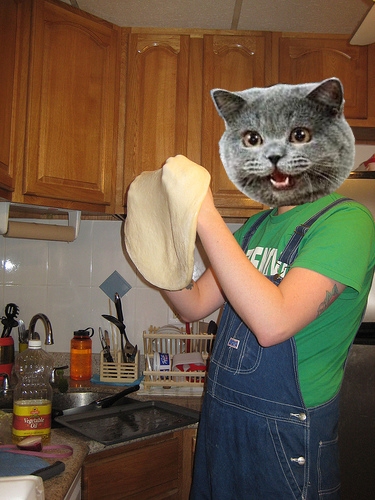
To stretch dough:
Once the dough was stretched, I set too prepping all of my ingredients. There are very few things in this world that I am anal about. Food prep is one of them. Clockwise starting with the plate, we have Follow Your Heart cheese, red onion, thin sliced zuchini, spicy olives and marinated artichoke hearts. Not pictured is veggie burger crumble, which I kept in the freezer.
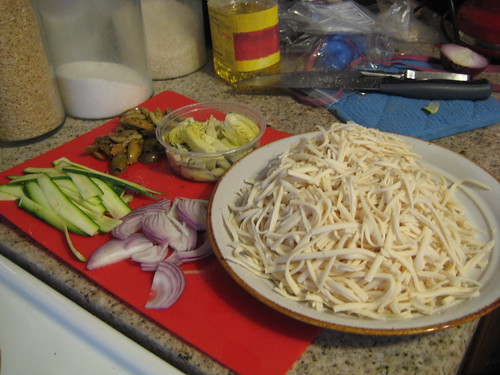
Once the the dough had set for about 20 minutes, I got it ready to hop in the oven. I made two pies:
One White -
Crust smeared with:
1/2 head of garlic, 1 tbsp olive oil and the ends of the soy cheese that got too small to safely grate. Put all ingredients in a food processor or blender and puree into a paste.
Topped with:
Marinated artichoke hearts, cut into 8ths, thinly sliced zucchini (I used a veggie peeler to keep my slices thin and consistent) red onions and soy cheese.
One Red -
Crust smeared with: Left over Fra Diavlo sauce, but any left over pasta sauce would work ok (as long as you made it your self.)
Topped with: Veggie burger crumbles, spicy olives and soy cheese.
The red pie waiting on deck

Baking the pies:
The white pie just about firm enough to come out of the pan and finish baking.
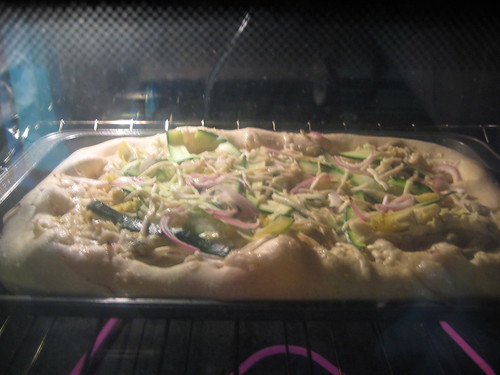
A plate of amazing
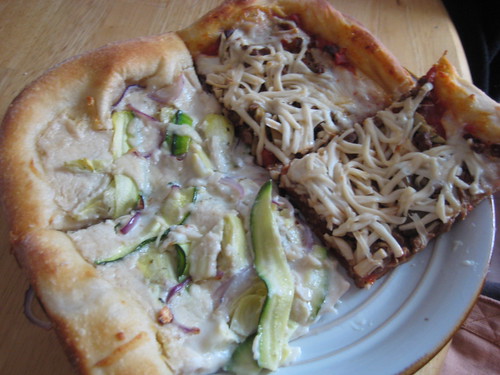
A first person view of the best moment of my year.
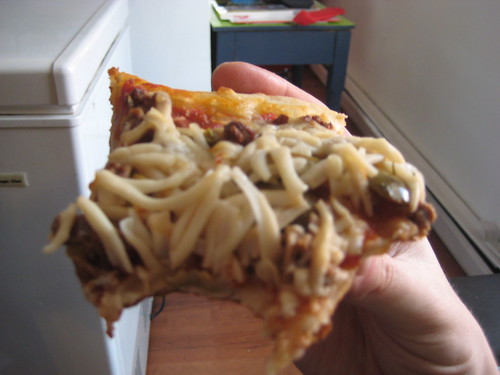
I already had some left over fra diavlo sauce from last week, so that was all the push I needed. I set off in the gorgeous Sunday sun, in search of ingredients. A stop at some Italian Market veggie stands, whole foods and a pizza place that has decent crust, yeilded marinated artichoke hearts, spicy olives, zucchini, red onions, fresh raw dough and Follow Your Heart soy cheese(I know that I talk a mean game about not wasting money on pre-packaged foods, but this stuff is awesome and totally worth shelling out a little extra cash for.) I then headed right home and got to work. All told I spent maybe $20 on ingredients for two huge gourmet pizzas.
You will notice that I bought dough from a pizzeria, instead of making my own. Not all pizzerias will sell raw dough, but some will. Having a good relationship with the owner certainly helps. Most of the time I do make my own dough, but I was more interested in spending the afternoon walking around in the sun, then fussing with dough. If you want to take a shot at making your own, I use Peter Reinhart's recipe from his book, The Bread Baker's Apprentice that I found in the 101 Cookbooks Blog
First I stretched the dough out and set it in sheet pans, which I then covered with a damp towel to rise a bit. I prefer a pan style pizza. I like how the edge crust rises up nice, and the under crust is crispy. My face is covered in this picture, not because I care that anyone knows what I look like, but because I look like a total goon. It is a good picture of dough stretching though.

To stretch dough:
- Start by spreading a healthy layer of flour on your counter.
- Put your dough ball on the counter and use your palms to press it down into a flat disk. I find it best to use a slight turning motion while pressing repeatedly.
- Once the ball is a disc, make a sign languace C with both hands, laying the dough over the back of your knuckles.
- begin rotating the dough and stretching it slightly by skooting your hands back and forth. Most of the stretching should come from the weight of the dough, not from your movement. Be careful to keep your hands towards the edge, or the center will get too thin.
- If you use rectangular pans like I do, stretch the dough until it overlaps the narrower sides of the pan by about an inch on each side, and then man handle it a little to make it fit the rectangular shape.
- Make sure that the pan is greased with vegetable oil before you put the crust in it.
Once the dough was stretched, I set too prepping all of my ingredients. There are very few things in this world that I am anal about. Food prep is one of them. Clockwise starting with the plate, we have Follow Your Heart cheese, red onion, thin sliced zuchini, spicy olives and marinated artichoke hearts. Not pictured is veggie burger crumble, which I kept in the freezer.

Once the the dough had set for about 20 minutes, I got it ready to hop in the oven. I made two pies:
One White -
Crust smeared with:
1/2 head of garlic, 1 tbsp olive oil and the ends of the soy cheese that got too small to safely grate. Put all ingredients in a food processor or blender and puree into a paste.
Topped with:
Marinated artichoke hearts, cut into 8ths, thinly sliced zucchini (I used a veggie peeler to keep my slices thin and consistent) red onions and soy cheese.
One Red -
Crust smeared with: Left over Fra Diavlo sauce, but any left over pasta sauce would work ok (as long as you made it your self.)
Topped with: Veggie burger crumbles, spicy olives and soy cheese.
The red pie waiting on deck

Baking the pies:
- Pizza LOVES a very hot oven. I usually bake pies at 550 degrees, which is as hot as most conventional ovens will go.
- If you have a pizza stone, take out your oven racks and place the stone on the bottom for gas ovens. For electric ovens, put your stone on the lowest rack.
- Start your pies in the sheet pan, and leave your oven light on, you will need to watch them pretty closely. As the pies grow bubbles, reach in and pop them with a knife or pizza cutter, so you don't end up with a mutant pizza.
- Check the pie every few minutes by lifting a corner slightly with a spatula. When the crust is firm enough that the pie starts to lift out, instead of just bending the corner, slip the pie out of the pan and let it finish just sitting on the rack or stone.
- Your pie is done when the outer crust has a nice golden brown color.
The white pie just about firm enough to come out of the pan and finish baking.

A plate of amazing

A first person view of the best moment of my year.

